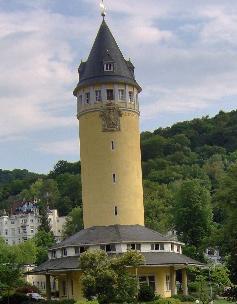Bad Ems
| Bad Ems | ||
|---|---|---|

A Water tower built in Bad Ems in 1907
|
||
|
||
| Coordinates: 50°20′17″N 7°42′38″E / 50.33806°N 7.71056°ECoordinates: 50°20′17″N 7°42′38″E / 50.33806°N 7.71056°E | ||
| Country | Germany | |
| State | Rhineland-Palatinate | |
| District | Rhein-Lahn-Kreis | |
| Municipal assoc. | Bad Ems | |
| Government | ||
| • Mayor | Ottmar Canz (CDU) | |
| Area | ||
| • Total | 15.36 km2 (5.93 sq mi) | |
| Elevation | 80 m (260 ft) | |
| Population (2015-12-31) | ||
| • Total | 9,229 | |
| • Density | 600/km2 (1,600/sq mi) | |
| Time zone | CET/CEST (UTC+1/+2) | |
| Postal codes | 56130 | |
| Dialling codes | 02603 | |
| Vehicle registration | EMS | |
| Website | www.bad-ems.de | |
Bad Ems is a town in Rheinland Pfalz, Germany. It is the county seat of the Rhein-Lahn rural district and is well known as a bathing resort on the river Lahn. Bad Ems is the seat of the Verbandsgemeinde ("collective municipality") Bad Ems.
The town is built on both sides of the River Lahn, the natural border between the Taunus and the Westerwald, two parts of the Rhenish Slate Mountains. The town and its outer districts are also within the Nassau Nature Reserve.
The town is linked to a view point at the Bismarckturm (Bismarck Tower) by the Kurwaldbahn funicular railway. Bad Ems station lies on the Lahn Valley Railway.
In Roman times, a castle was built at Bad Ems as part of the Upper Germanic Limes, but today not much of the structure remains. In the woods around the town, however, there are distinct traces of the former Roman border.
The town was first mentioned in official documents in 880 and received its town charter in 1324. The Counts of Nassau and Katzenelnbogen rebuilt the bath. The high noble Counts loved to use it inviting friends. Days in the bath were often days with musicians and all kinds of food even swimming in the pool. In the 17th and 18th centuries it was considered one of Germany's most famous bathing resorts. It reached its heyday in the 19th century when it welcomed visitors from all over the world and became the summer residence of various European monarchs and artists, including Kaiser Wilhelm I of Germany, Tsars Nicholas I and Alexander II of Russia, Richard Wagner, Fyodor Dostoevsky and Vasili Vasilyevich Vereshchagin, etc.
...
Wikipedia



